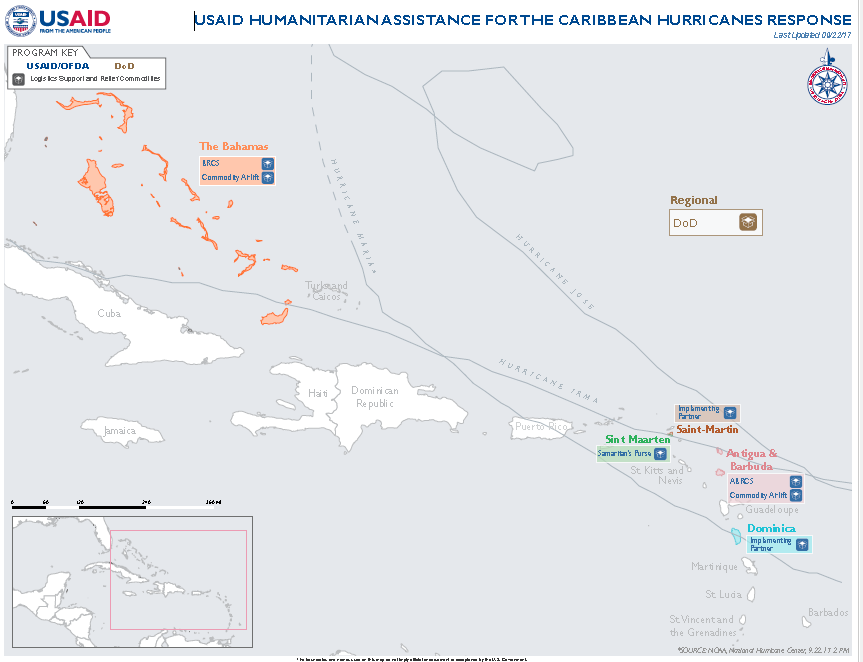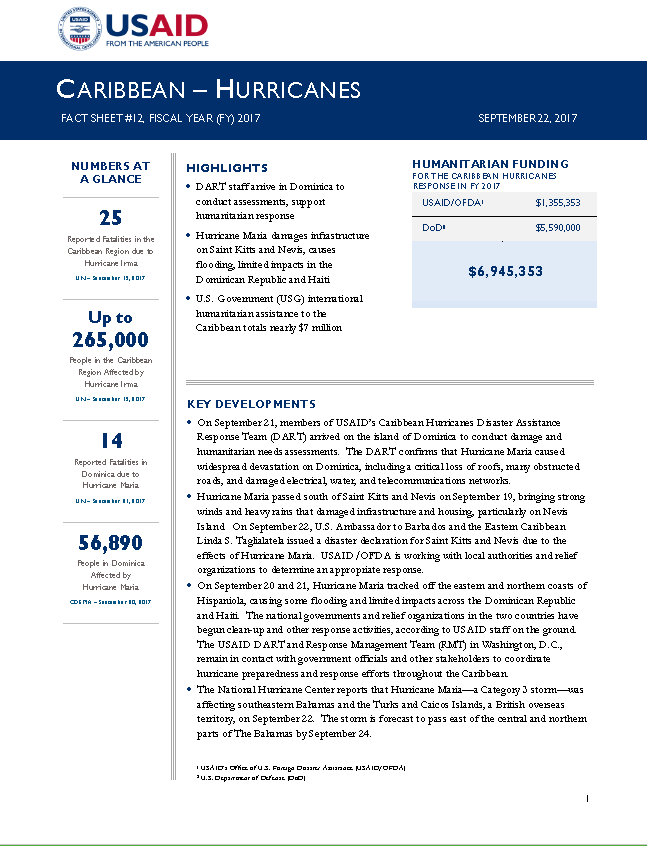Speeches Shim
September 22, 2017
Highlights
- DART staff arrive in Dominica to conduct assessments, support humanitarian response.
- Hurricane Maria damages infrastructure on Saint Kitts and Nevis, causes flooding, limited impacts in the Dominican Republic and Haiti.
- U.S. Government (USG) international humanitarian assistance to the Caribbean totals nearly $7 million.
Key Developments
On September 21, members of USAID’s Caribbean Hurricanes Disaster Assistance Response Team (DART) arrived on the island of Dominica to conduct damage and humanitarian needs assessments. The DART confirms that Hurricane Maria caused widespread devastation on Dominica, including a critical loss of roofs, many obstructed roads, and damaged electrical, water, and telecommunications networks.
Hurricane Maria passed south of Saint Kitts and Nevis on September 19, bringing strong winds and heavy rains that damaged infrastructure and housing, particularly on Nevis Island. On September 22, U.S. Ambassador to Barbados and the Eastern Caribbean Linda S. Taglialatela issued a disaster declaration for Saint Kitts and Nevis due to the effects of Hurricane Maria. USAID/OFDA is working with local authorities and relief organizations to determine an appropriate response.
On September 20 and 21, Hurricane Maria tracked off the eastern and northern coasts of Hispaniola, causing some flooding and limited impacts across the Dominican Republic and Haiti. The national governments and relief organizations in the two countries have begun clean-up and other response activities, according to USAID staff on the ground. The USAID DART and Response Management Team (RMT) in Washington, D.C., remain in contact with government officials and other stakeholders to coordinate hurricane preparedness and response efforts throughout the Caribbean.
The National Hurricane Center reports that Hurricane Maria—a Category 3 storm—was affecting southeastern Bahamas and the Turks and Caicos Islands, a British overseas territory, on September 22. The storm is forecast to pass east of the central and northern parts of The Bahamas by September 24.
Caribbean Hurricanes - Map #12 ![]() (pdf - 271k)
(pdf - 271k)
Numbers At A Glance
25
Up to 265,000
14
56,890
Humanitarian Funding
For the Caribbean Hurricanes in FY 2017
| USAID/OFDA | $1,355,353 |
| DoD | $5,590,000 |
| Total | $6,945,353 |
Caribbean Hurricanes - Fact Sheet #12 ![]() (pdf - 190k)
(pdf - 190k)
DOMINICA
Hurricane Maria had caused at least 14 fatalities on the island of Dominica as of September 21, and the death toll is expected to rise as access to remote areas improves, according to the UN. The Category 5 hurricane affected nearly 57,000 people—approximately 80 percent of the island’s total population—when it passed over Dominica, the Caribbean Disaster Emergency Management Agency (CDEMA) reports.
On September 21, members of the DART arrived on Dominica to conduct initial damage and needs assessments. Prior to landing, DART staff aerially assessed Dominica and confirmed severe damages to houses on the island, particularly the widespread loss of roofs. The DART reports many roads are impassable due to landslides, flooding, or destroyed bridges. The DART also confirmed Hurricane Maria’s negative impacts on the island’s electrical, water, and telecommunications networks.
Upon arrival, DART staff immediately met with airport officials and the local police force at Canefield and Douglas-Charles airports. Douglas-Charles is Dominica’s main airport, located in the northeast, while Canefield Airport is the island’s second, smaller airport, situated approximately 3 miles north of the capital of Roseau. The DART is consulting airport and local authorities to determine the logistical capacities of each airport to receive relief commodities. DART staff report that the road from Canefield Airport to Roseau is open; however, roads running south from the Douglas-Charles Airport are blocked.
The DART is coordinating with the Government of the Commonwealth of Dominica Emergency Operations Center, CDEMA, UN agencies, and other international donors in Dominica to ensure a synchronized humanitarian response to Hurricane Maria’s destruction. Early observations from the DART and other assessment teams on the ground suggest shelter and water, sanitation, and hygiene assistance as priority needs on Dominica.
DOMINICAN REPUBLIC
On September 20 and 21, Hurricane Maria passed off the eastern and northern coasts of the Dominican Republic as a Category 3 storm. As of September 22, the hurricane had caused extensive flooding, displaced more than 16,700 people, damaged nearly 3,000 houses, and affected approximately 40 water systems, according to international media and the Government of the Dominican Republic (GoDR).
A team of 12 USAID/OFDA surge capacity consultants plans to conduct initial damage and needs assessments throughout hurricane-affected areas of the Dominican Republic on September 22. A USAID/OFDA disaster risk management specialist (DRMS) remains in contact with GoDR emergency authorities and is engaging with humanitarian organizations to coordinate response efforts if needed.
HAITI
Preliminary reports from the Government of Haiti (GoH) on September 22 indicate that the passage of Hurricane Maria caused limited impacts in the country, according to USAID/OFDA staff based in the capital city of Port-au-Prince. USAID/OFDA surge capacity consultants and humanitarian partners in northern Haiti report that heavy rains associated with Hurricane Maria caused localized flooding in the departments of Artibonite, Nord, and Nord-Est.
SAINT KITTS AND NEVIS
Hurricane Maria passed south of Saint Kitts and Nevis as a Category 5 storm on September 19, bringing strong winds and heavy rains to the two-island country. Initial reports indicate significant damage to roofs, roads, and electrical and water infrastructure, particularly on Nevis Island. While damage assessments are ongoing, the Government of Saint Kitts and Nevis has identified plastic sheeting as a preliminary priority need, according to CDEMA.
On September 22, U.S. Ambassador to Barbados and the Eastern Caribbean Linda S. Taglialatela issued a disaster declaration for Saint Kitts and Nevis due to the effects of Hurricane Maria. USAID/OFDA has deployed a DRMS to Saint Kitts and Nevis to conduct damage assessments and liaise with local government officials and other stakeholders on the response, in collaboration with the two local surge capacity consultants that USAID/OFDA had activated for Saint Kitts and Nevis ahead of the storm.
ST. MARTIN
Access to potable water remains a priority need in the French overseas collectivity of Saint-Martin.3 In coordination with the DART, Joint Task Force-Leeward Islands (JTF-LI)—consisting of members from DoD’s Southern Command—have delivered eight lightweight desalination units to Saint-Martin. As of September 21, the JTF-LI had re-established the two water-production sites, each with four desalination units, and had recommenced the production of water for household use. Between September 15 and 22, the desalination units generated more than 41,500 gallons, or approximately 157,300 liters, of potable water.
To ensure that residents are aware of the available water supplies, the local Saint-Martin radio station plans to announce the locations of the desalination sites beginning on September 22 and encourage residents to collect water at the sites. The DART and DoD continue to collaborate with the Government of France and local officials in Saint-Martin to facilitate access to safe water for hurricane-affected communities.
Since September 9, JTF-LI has supported USAID’s international humanitarian response efforts to hurricanes Irma and Maria. As of September 21, DoD had contributed nearly $5.6 million in Overseas Humanitarian, Disaster, and Civic Aid funds in logistics support. To date, the USG has provided nearly $7 million in international humanitarian assistance for the Caribbean Hurricanes response.
CONTEXT
Hurricane Irma—the strongest Atlantic hurricane on record—began affecting the eastern Caribbean in early September. On September 6, the hurricane made landfall over the island of Barbuda in the northeastern Caribbean before passing near The Bahamas, the Dominican Republic, and Haiti and making secondary landfall in Cuba on September 9. The hurricane brought destructive winds, heavy rainfall, and dangerous storm surge, resulting in at least 25 fatalities and causing significant infrastructure damage across the Caribbean region.
On September 9 and 10, Hurricane Jose passed north of the Leeward Islands and proceeded into the North Atlantic Ocean, causing minimal impacts in the Caribbean region.
On September 6, U.S. Chargé d’Affaires, a.i., Lisa A. Johnson issued a disaster declaration in response to the anticipated effects of Hurricane Irma in The Bahamas, and on September 7, U.S. Ambassador to Barbados and the Eastern Caribbean Linda S. Taglialatela issued a disaster declaration in response to Hurricane Irma and the anticipated effects of Hurricane Jose in Antigua and Barbuda. In response, USAID/OFDA contributed an initial $100,000 each to the Bahamas Red Cross Society and the Antigua and Barbuda Red Cross Society.
On September 7, USAID activated a regional DART and stood up a Washington, D.C.-based RMT to coordinate the USG’s humanitarian response to the hurricanes.
On September 9, U.S. Embassy in Paris Chargé d’Affaires D. Brent Hardt issued a disaster declaration for the French Saint-Martin, and on September 10, U.S. Embassy in The Hague Chargé d’Affaires Shawn Crowley declared a disaster for Sint Maarten due to the effects of Hurricane Irma and anticipated effects of Hurricane Jose. In response, USAID/OFDA contributed an initial $100,000 each for activities in Saint-Martin and Sint Maarten.
On the night of September 18, Hurricane Maria passed directly over Dominica as a Category 5 storm, causing catastrophic damage across the island. On September 19, Ambassador Taglialatela issued a disaster declaration for Dominica, and in response, USAID/OFDA provided an initial $100,000 to address priority needs.
PUBLIC DONATION INFORMATION
The most effective way people can assist relief efforts is by making cash contributions to humanitarian organizations that are conducting relief operations. A list of humanitarian organizations that are accepting cash donations for disaster responses around the world can be found at www.interaction.org.
USAID encourages cash donations because they allow aid professionals to procure the exact items needed (often in the affected region); reduce the burden on scarce resources (such as transportation routes, staff time, and warehouse space); can be transferred very quickly and without transportation costs; support the economy of the disaster-stricken region; and ensure culturally, dietary, and environmentally appropriate assistance.
More information can be found at: USAID Center for International Disaster Information: www.cidi.org or +1.202.661.7710. Information on relief activities of the humanitarian community can be found at www.reliefweb.int.



Comment
Make a general inquiry or suggest an improvement.